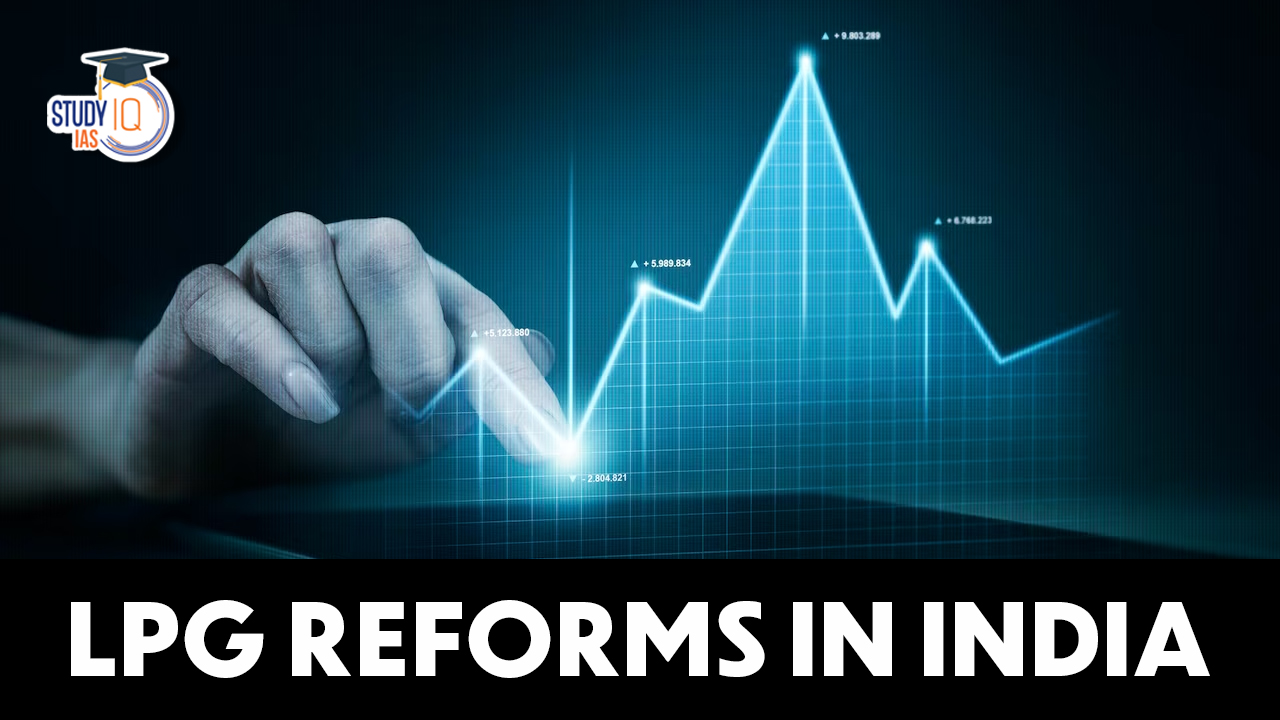Table of Contents
LPG Reforms in India
In the wake of rapid globalization and the pursuit of economic progress, India underwent a transformative phase that reshaped its economic landscape. Liberalisation, Privatisation, and Globalisation (LPG) reforms emerged as the catalysts behind this significant shift, marking a departure from the era of centralized planning and embracing a more open and market-oriented approach.
These reforms, driven by the desire to tap into the vast potential of a globalized world, brought about sweeping changes across various sectors, propelled India towards integration with the global economy, and unleashed newfound opportunities for growth and development. This article delves into the multifaceted dimensions of the LPG reforms in India.
Read about: External Debt of India
What is LPG Reforms?
The term LPG stands for Liberalization, Privatization, and Globalization, representing the three core areas of focus in the Indian government’s New Economic Policy of 1991. The LPG Policy was introduced under the leadership of Prime Minister Shri P V Narasimha Rao and Finance Minister Dr. Manmohan Singh.
Liberalization aimed to reduce government control and regulations, while privatization involved transferring ownership of state-owned enterprises to the private sector. Globalization focused on expanding economic activities and integrating India with the global economy. Together, these three pillars formed the basis of the LPG reforms, marking a significant shift in India’s economic policies.
Read about: Concept of GDP, GNP, NNP and NDP
Why was LPG Policy introduced in India?
The introduction of LPG reforms in India was prompted by various economic factors and global circumstances. The pre-LPG era was characterized by a state-controlled, closed economy with limited private ownership. The following factors contributed to the need for LPG reforms:
- Balance of Payments Crisis: India faced a deficit in foreign currency, leading to low foreign exchange reserves and a growing debt burden.
- Underperforming Public Sector Undertakings (PSUs): Many PSUs were incurring losses, becoming a financial burden for the government.
- Fiscal Deficit and Public Debt: The government grappled with a fiscal deficit and substantial public debt, posing challenges to financial stability.
- High Inflation: Inflation rates soared, necessitating measures to address economic instability and rising prices.
- License Raj: Government restrictions and bureaucratic hurdles hindered business growth and discouraged private enterprise.
In addition to these domestic factors, global circumstances also influenced the adoption of LPG reforms:
- Lessons from the Fall of the Soviet Union: The collapse of the Soviet Union highlighted the limitations of a purely socialist approach, prompting India to reevaluate its economic policies.
- Financial Crunch after the 1990-91 Iraq War: The disruption of foreign currency inflows due to the Iraq War created a financial crunch, necessitating reforms to address the situation.
Collectively, these factors and global events compelled the Indian government to introduce LPG reforms to modernize the economy, attract foreign investments, address fiscal challenges, and align India’s economic goals with global trends.
Read About: Circular Flow of Income
Objectives of LPG Reforms
The LPG Reforms in India were introduced to achieve the following objectives:
- Economic Transformation: Shift the Indian economy from a Soviet-style model to a market economy with reduced government control and increased economic activity.
- Address Balance of Payments Crisis: Resolve the balance of payments deficit and strengthen India’s foreign exchange reserves.
- Promote Economic Growth: Stimulate economic growth and expansion by integrating Indian businesses into global trade markets.
- Facilitate International Trade: Enable the flow of goods, services, and capital across international borders, promoting trade and economic exchanges.
- Encourage Private Sector Participation: Foster increased participation of private entities in various sectors of the economy, promoting competition, innovation, and efficiency.
Read about: Gross National Product
Features of LPG Reforms
The LPG reforms under the New Economic Policy of 1991 introduced measures that opened up the Indian economy and reduced government restrictions. The features of the LPG Policy in India can be summarized as follows.
| Liberalization | Privatization | Globalization |
| Deregulation | Transfer of PSU ownership | Trade liberalization |
| Tariff reduction | Disinvestment of PSUs | Foreign direct investment |
| Market-oriented policies | Public-private partnerships | Integration into global markets |
| Financial sector reforms | Asset monetization | Technology transfer |
| Competition promotion | Market competition | Cross-border trade |
| Easing of licensing norms | Private sector participation | Access to global capital |
| Removal of trade barriers | Strategic sales | Economic diplomacy |
| FDI promotion | Commercialization of assets | International collaborations |
| Exchange rate reforms | Capital market reforms | Export-oriented policies |
| Intellectual property rights | VRS and employee buyouts | Global supply chain integration |
Read about: NRI Deposits
Benefits of LPG Reforms
The LPG reforms in India resulted in several positive outcomes for the economy. The benefits of the LPG Policy can be summarized as follows:
- Balance of Payments Improvement: Overcoming the balance of payments crisis and reducing reliance on foreign loans.
- Fiscal Deficit Reduction: Privatization of inefficient PSUs, leading to reduced government expenditure and losses.
- Economic Growth: Encouraging competition through reduced government restrictions, promoting private sector participation, and countering state monopolies.
- Global Market Participation: Enabling India’s entry into global trade markets and establishing its position as a major developing country.
Read about: FERA and FEMA
LPG Reforms in India UPSC
The topic of LPG reforms is crucial for UPSC as it is directly linked to the UPSC Syllabus, particularly in the Economics and Indian Economy sections. A comprehensive understanding of the LPG reforms, including liberalization, privatization, and globalization, is essential for aspirants preparing for the UPSC exam. Candidates can cover such topics from UPSC Online Coaching platform and check their conceptual clarity by joining UPSC Mock Test. This will help candidates to grasp the concepts, their implications, and their impact on the Indian economy to excel in the examination.
Read about: GDP Deflator


 World Oceans Day 2025, History, Theme, S...
World Oceans Day 2025, History, Theme, S...
 World Environment Day 2025, Theme, Histo...
World Environment Day 2025, Theme, Histo...
 Unemployment Rate in India, Current Rate...
Unemployment Rate in India, Current Rate...





















